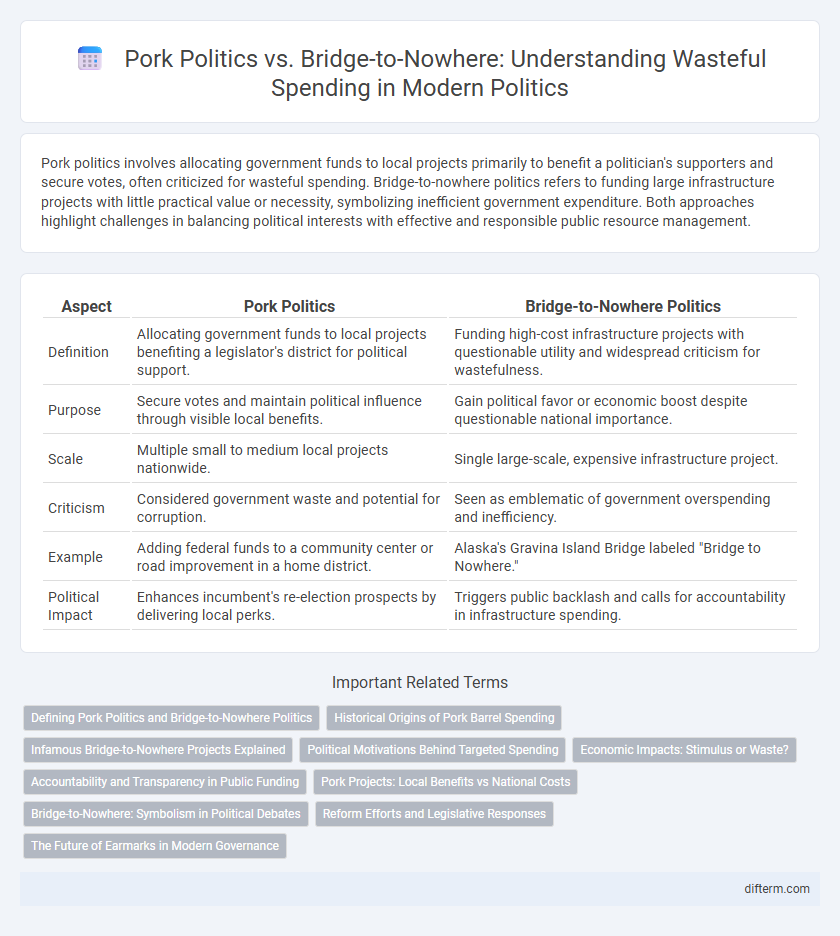Pork politics involves allocating government funds to local projects primarily to benefit a politician's supporters and secure votes, often criticized for wasteful spending. Bridge-to-nowhere politics refers to funding large infrastructure projects with little practical value or necessity, symbolizing inefficient government expenditure. Both approaches highlight challenges in balancing political interests with effective and responsible public resource management.
Table of Comparison
| Aspect | Pork Politics | Bridge-to-Nowhere Politics |
|---|---|---|
| Definition | Allocating government funds to local projects benefiting a legislator's district for political support. | Funding high-cost infrastructure projects with questionable utility and widespread criticism for wastefulness. |
| Purpose | Secure votes and maintain political influence through visible local benefits. | Gain political favor or economic boost despite questionable national importance. |
| Scale | Multiple small to medium local projects nationwide. | Single large-scale, expensive infrastructure project. |
| Criticism | Considered government waste and potential for corruption. | Seen as emblematic of government overspending and inefficiency. |
| Example | Adding federal funds to a community center or road improvement in a home district. | Alaska's Gravina Island Bridge labeled "Bridge to Nowhere." |
| Political Impact | Enhances incumbent's re-election prospects by delivering local perks. | Triggers public backlash and calls for accountability in infrastructure spending. |
Defining Pork Politics and Bridge-to-Nowhere Politics
Pork politics involves legislators securing government funds for localized projects to benefit their constituents, often criticized for fostering wasteful spending and political favoritism. Bridge-to-nowhere politics refers to funding federal projects that appear unnecessary or lack practical utility, symbolizing inefficient allocation of taxpayer money. Both concepts highlight the challenges of balancing local interests with responsible national budget management.
Historical Origins of Pork Barrel Spending
Pork barrel spending originated in the early 19th century United States as legislators sought to secure federal funds for local projects benefiting their constituencies, often emphasizing tangible infrastructure like roads and canals. The term "bridge-to-nowhere" evolved later, symbolizing absurd or wasteful funding for projects with questionable necessity, reflecting increased scrutiny of allocative inefficiency. Historical analysis reveals that pork politics entrenched patronage and localism, while bridge-to-nowhere critiques spotlight growing demands for fiscal accountability and transparency in public expenditures.
Infamous Bridge-to-Nowhere Projects Explained
The infamous Bridge-to-Nowhere projects epitomize wasteful federal spending, where billions were allocated for infrastructure with little practical use or benefit to the public. These projects often emerge from Pork politics, where legislators secure funding to favor local interests and boost political support despite questionable necessity. Examining cases like Alaska's Gravina Island Bridge reveals how such expenditures become symbols of inefficiency and the need for stricter budget oversight in politics.
Political Motivations Behind Targeted Spending
Pork politics centers on legislators securing localized funding to benefit their own districts, driven by the desire to win voter support and ensure re-election. Bridge-to-nowhere politics exemplifies wasteful spending where projects are backed despite lacking broad economic justification, often influenced by political bargaining and special interest lobbying. Both strategies reveal how targeted federal expenditures are frequently shaped more by political motivations and electoral gains than by objective assessments of public need or efficiency.
Economic Impacts: Stimulus or Waste?
Pork politics channels federal funds into local projects to stimulate economic growth and create jobs, often boosting regional development through targeted infrastructure and community investments. Bridge-to-nowhere politics represents wasteful spending on unnecessary or redundant projects that generate little economic return and burden taxpayers with inflated costs. Evaluating these policies through cost-benefit analyses reveals that while pork spending can drive economic stimulus, bridge-to-nowhere initiatives frequently result in inefficient allocation of public resources and limited long-term benefits.
Accountability and Transparency in Public Funding
Pork politics often involves small-scale, localized projects with opaque funding allocations that challenge transparency and hinder public accountability. In contrast, bridge-to-nowhere politics typically features large, costly infrastructure projects criticized for poor oversight and ineffective use of public funds. Ensuring stricter mechanisms for transparency and accountability in both types of public funding is essential to prevent misuse and promote responsible governance.
Pork Projects: Local Benefits vs National Costs
Pork politics prioritize securing local benefits through targeted government spending projects that directly impact specific constituencies, often boosting local economies and political support. These pork projects typically involve funding for infrastructure, community facilities, and other visible developments but can lead to inefficient allocation of resources and increased national debt. Contrasting with bridge-to-nowhere politics, pork projects emphasize local gains despite sometimes significant long-term national fiscal costs and policy trade-offs.
Bridge-to-Nowhere: Symbolism in Political Debates
The Bridge-to-Nowhere symbolizes wasteful federal spending and the pitfalls of earmark-driven politics, often highlighted in debates as a cautionary example of failed infrastructural priorities. Its notoriety stems from the 2005 proposal to fund a $398 million bridge in Alaska, which critics argue exemplifies pork barrel spending disconnected from broader public benefit. This symbol serves to critique politicians who prioritize localized projects over efficient allocation of resources, fueling discussions on government accountability and fiscal responsibility.
Reform Efforts and Legislative Responses
Reform efforts targeting pork politics emphasize increasing transparency and accountability in federal budget allocations to reduce wasteful spending on local projects lacking national significance. Legislative responses include measures such as the 2006 Honest Leadership and Open Government Act, which aims to curb earmarks and enhance disclosure requirements for congressional spending. In contrast, bridge-to-nowhere politics has prompted targeted interventions exemplified by the cancellation of Alaska's Gravina Island Bridge project, reflecting growing public and political opposition to funding emblematic of overly parochial priorities.
The Future of Earmarks in Modern Governance
Earmarks, once synonymous with pork politics, are increasingly scrutinized for their role in funneling federal funds to local projects without competitive transparency. The debate between pork barrel spending and the so-called bridge-to-nowhere politics highlights the tension between allocating resources for regional development and ensuring fiscal responsibility in modern governance. Moving forward, reform-minded policymakers seek to balance targeted investments with accountability measures to restore public trust in earmark processes.
Pork politics vs Bridge-to-nowhere politics Infographic

 difterm.com
difterm.com